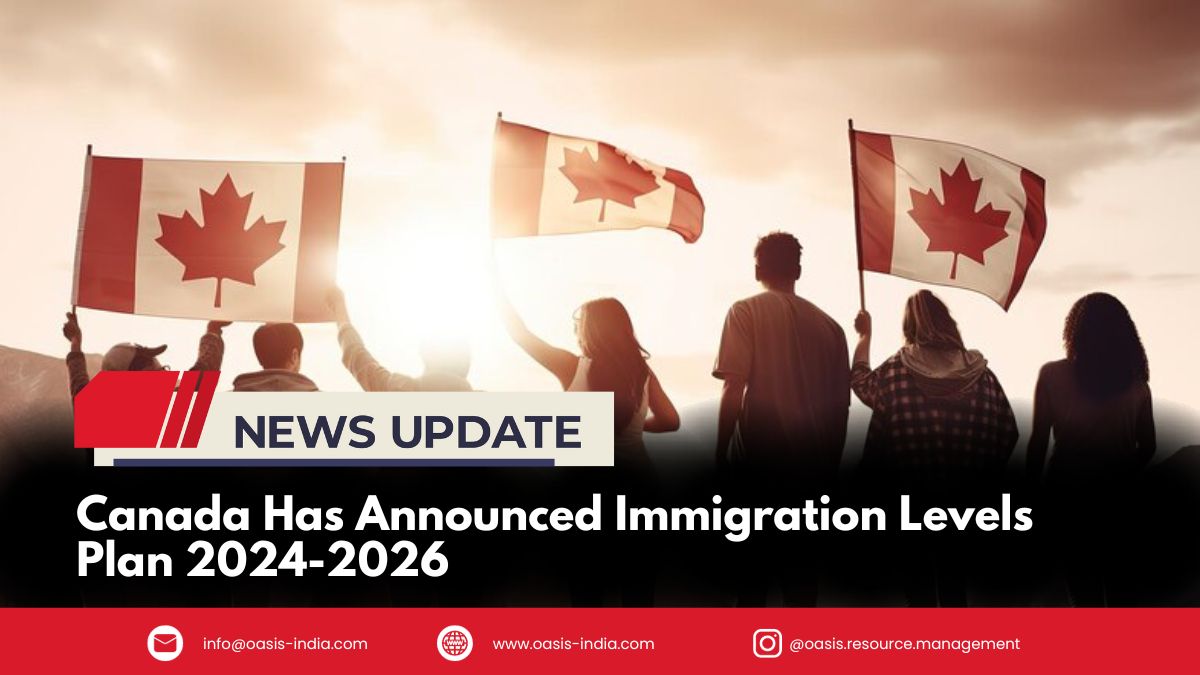
Canada has announced the Immigration levels plan 2024-2026. There will be no deviation in the immigration levels of Canada from its current targets.
485,000 immigrants will be admitted by the country in the year 2024 and in the year 2025 and 2026, Canada will be looking forward to welcoming 500,000 new immigrants every year. Targets will not change, they are going to remain the same as they were under the immigration levels plan 2023-2025. There are updates about the immigration targets of 2026 as well as about the levels of immigrants that will be admitted under every class and program between 2024 and 2026.
Breakdown of Immigration Targets
The Land of Maple Leaf is going to welcome about 281,135 immigrants under the economic class, 58% of the annual target. This will increase up to 301,250 immigrants, or 60% of the annual target by 2026. 24% of all admissions or 114,000 immigrants will be the target of the family class in 2024. This count will increase up to 118,000 immigrants by the year 2026, which will also be 24% of all admissions.
19% of all admissions will be the humanitarian targets In 2024, humanitarian targets, i.e., 89,865 immigrants. Protected persons, refugees, and those admitted for humanitarian, compassionate, or other reasons are included by these totals. 16% of admissions or 80,832 immigrants will be the target by 2026. Due to rounding off, these figures may not add up to 100%.
Express Entry and PNP Targets to Increase
There will be an increment in the Express Entry Canada and Provincial Nominee Programs (PNPs) immigration targets as shown in the table below:
| Immigration Program | Express Entry | Provincial Nominee Program (PNP) | Spousal, Partner and Children Sponsorship | Parents and Grandparents Program (PGP) |
| Immigration Target in 2024 | 110,700 | 110,000 | 82,000 | 32,000 |
| Immigration Target in 2025 | 117,500 | 120,000 | 84,000 | 34,000 |
| Immigration Target in 2026 | 117,500 | 120,000 | 84,000 | 34,000 |
Efforts of Stabilization of Immigration Levels by the Canadian Government
The cause of keeping the target unchanged is explained by the Canadian government. The plan is tailored to support economic growth, according to the government, while balancing the pressures in areas like housing, healthcare, and infrastructure. For sustainable and stable population growth, a responsible course is charted. At 550,000, the government will stabilize permanent resident levels, permitting time for successful integration while continuing to augment the labour market of Canada starting in 2026.
The annual plan is released by the federal government by November 1 in non-election years under the Immigration and Refugees Protection Act (IRPA) which is Canada’s main immigration law. For the number of new permanent residents who are going to be admitted into Canada over the next 3 years under each one of the three immigration classes – family, economic, and humanitarian, immigration Levels Plan can be considered as the guideline.
The aim of Immigration, Refugees and Citizenship Canada (IRCC) is to reunite families, strengthen the economy of Canada, and make Canada a safe haven for people fleeing oppression. This objective is advanced by Immigration Levels Plan. In 2022, the record for new immigrants was broken by Canada at 437,000. 465,000 is the target for permanent resident admissions in 2023.
What is the New Strategy to Improve Immigration System by Canada?
To improve the immigration system, after Canada unveiled a new strategy, the Immigration Levels Plan 2024-2026 was introduced. Marc Miller outlined the pillars of a new approach to modernize the system as the shortcomings in the immigration system of the country were acknowledged by him, on October 31.
Creating a more welcoming environment for the newcomers, developing a comprehensive and coordinated growth plan, and aligning immigration with the labour market needs are the three major goals of the new strategy titled “An Immigration System for Canada’s Future”.
A more user-friendly and pleasant experience for its clients is about to be delivered by IRCC. With is skills and strategy, IRCC would also like to better align the immigration policies of Canada. In addition, an integrated plan is probably being developed by IRCC among all 3 of Canada’s levels of government to ensure the country can offer healthcare, adequate housing, and infrastructure to its growing newcomer population.
History of Increase in the Immigration Levels
The immigration strategy of Canada started to shift toward its recent form in the late 1980s. Planning for future immigration was not much emphasized by the government before this and generally set immigration levels on the basis of the economy of the day.
In 1984, fewer than 90,000 immigrants were welcomed by Canada. When the 1990s approached, the federal government was run by the Conservative Party. The government realized that the problem of labour shortage may occur soon and then it increased immigration targets to 250,000 new permanent residents over 8 years.
In 1993, the Liberal government was elected and continued to raise immigration targets. To help aid the economy in a recession, more focus was put on reducing Canada’s family and humanitarian class shares and admitting economic-class immigrants. On yearly basis, some 260,000 immigrants were then admitted until the current Liberal government was elected in 2015.
Under the current government led by Justin Trudeau, immigration targets were increased to 300,000, and then before the beginning of the COVID-19 pandemic in 2020, targets reached 340,000 shortly.
By landing 405,000 immigrants, Canada broke its record for permanent resident admissions despite pandemic restrictions in 2021. Canada is coping with an affordability crisis and housing shortage in recent times leading to several polls that indicate that Canadians are less enthusiastic about immigration in previous years.
Announcement of the Immigration Plan by Quebec
The only province in Canada with the ability to shape its annual permanent resident admission targets, i.e., Quebec, also announced the immigration levels plan for 2024 and 2025. To help preserve its distinct Francophone character, Quebec has the authority to shape its immigration targets. This province has a unique status in Canada. 50,000 immigrants will be welcomed by this Canadian province each year in 2024 and 2025.
The changing immigration landscape of Canada can create confusion sometimes, especially if you want to settle there, so Consult With Us! Oasis Visas is here to help you on your journey.









